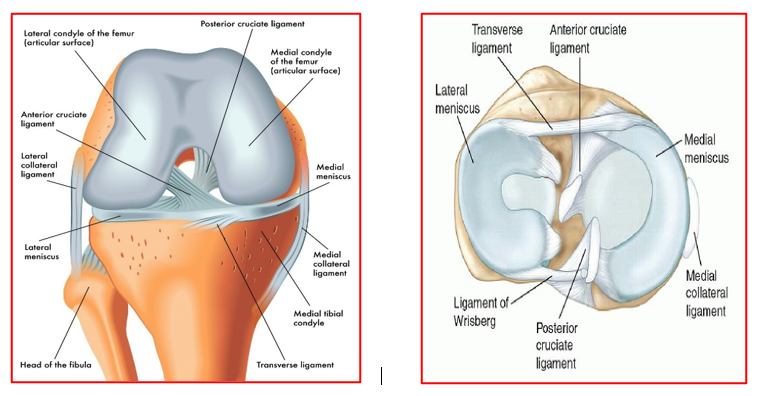Home >> Joints Services
Knee Anatomy and
Common Knee Problems
Knee Anatomy and Common Knee Problems
What is the anatomy of the knee joint?
The knee joint is one of the most complex joints of the body. The lower end of the thighbone (femur) meets the upper end of the shinbone (tibia) at the knee joint. A small bone called the patella (kneecap) rests on a groove called femoral trochlea on the front side of the lower femur. A bone of the lower leg (fibula) forms a joint with the shinbone called proximal tibio-fibular joint.
The articular surfaces of the bones are covered with a shiny white slippery articular cartilage. This highly specialised coating allows smooth, friction-less and painless motion of the knee joint.
There are two C-shaped cartilaginous discs, called menisci, that are present between the femur and the tibia. These menisci are attached firmly to the top surface of the tibia and the surrounding joint capsule. They act as shock absorbers providing cushion to the joints. Menisci also play an important role in providing stability and load bearing to the knee joint.

Bands of tissues called ligaments, act like strong ropes, to keep the different bones of the knee joint together and provide stabilization to the joint.
The four main ligaments in the knee are:
Two collateral ligaments – found on either side of the knee joint. The inner ligament is called the medial collateral ligament (MCL) and the outer ligament is called the lateral collateral ligament (LCL). The pair of collateral ligaments keeps the knee from moving too far side-to-side.
Two cruciate ligaments – found inside the knee joint.
The cruciate ligaments cross each other to form an ‘X’ configuration. The anterior cruciate ligament (ACL) is in the front and the posterior cruciate ligament (PCL) at the back of the knee.
ACL primarily prevents excessive forward motion of the tibia over the femur and also prevents rotation.
PCL prevents excessive backward movement of the tibia over the femur and also rotation.
The cruciate ligaments allow the tibia to “swing” back and forth under the femur without the tibia sliding too far forward or backward under the femur.
Working together, these 4 ligaments are the most important structures in controlling stability of the knee.
Surrounding muscles are connected to the knee bones by tendons. The bones work together with the muscles and tendons to provide mobility to the knee joint. The quadriceps tendon and the patellar tendon are in the front and they help in knee extension. The hamstring tendons (gracilis and semitendinosus) running obliquely from back to front. They help in knee flexion.
The whole knee joint is covered by a ligamentous capsule, which further stabilizes the joint. This ligamentous capsule is also lined with a synovial membrane that secretes synovial fluid for lubrication and frictionless joint motion.
What are the common knee problems?
Common Knee problems are:
-
Knee Arthritis due to Osteoarthritis, Rheumatoid arthritis or post traumatic
-
Anterior Cruciate Ligament (ACL) Tear
-
Meniscus tears
-
Discoid Meniscus & Meniscal Cyst
-
Posterior Cruciate Ligament (PCL) Tear
-
Articular Cartilage Injuries
-
Osteochondritis Dissecans
-
Chondromalacia Patellae
-
Lateral and Medial Collateral Ligament Injuries
-
Multi-ligament knee injuries
-
Patellar Dislocation and Instability
-
Patellofemoral syndrome (Runner’s Knee)
-
Tendinitis or Tears of the Patellar / Quadriceps tendon
-
Fractures around the knee joint
-
Gout
-
Plica Syndrome
-
Infectious Arthritis
-
Synovial Lesions
-
Iliotibial Band syndrome
-
Bursitis: pre-patellar, infra-patellar and pes anserinus bursitis
-
Osgood-Schlatter Disease
Book An Appointment
Private Clinics : Locations & Directions
London Joints Clinic (Pune)
Address
Office S 5, 2nd Floor, North Block, Sacred World Mall,
Opp Sacred Heart Township, Near Jagtap Chowk,
Wanawadi, Pune 411040
Monday, Wednesday & Friday 7 PM to 9 PM
Sunday 11 AM to 1 PM
Appointments
London Joints Clinic ( PCMC )
Address
C/O Dr Nitin’s Physio Clinic,
Opp. Brahma Hotel,
Near Akurdi Post Office,
Vivek Nagar,
Akurdi,
Pune 411035
Saturdays only 4.30 PM to 7.30 PM
Appointments
Hospitals OPDs : Locations & Directions
Manipal Hospital

Address
Manipal Hospital, Opp D Mart, Baner-Mhalunge Road, Baner, Pune 411 045
Monday to Saturday 11 AM to 4 PM
Appointments
Contact us
Dr Anand Jadhav has a centralised appointment system for all locations across various hospitals and clinics in Pune & PCMC areas
Appointment Bookings & Requests can be made by any method :

